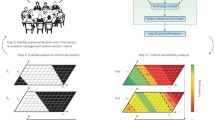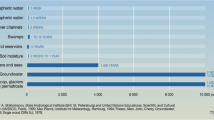Abstract
Efforts toward systematic conservation planning for freshwaters have progressed less than similar efforts in terrestrial and marine environments. Although there are important differences, many of the tools that have been used in terrestrial and marine systems can also be used for freshwater conservation planning. In this paper, we used return on investment (ROI) analysis to identify optimal riparian land conservation portfolios under different objectives. Our overarching research question is: how do different strategies for evaluating ROI objectives influence the resulting conservation portfolio and the outcome of interest, lake water quality? We examined agricultural riparian land investments to improve water quality in 55 inland lakes in southwestern Michigan. We simulated investments and compared the ROIs for the following strategies: (1) economic; (2) ecological; and (3) environmental policy. Furthermore, as a reference point, we also compared the resulting three conservation portfolios to that derived by simulating riparian land enrollment under the Conservation Reserve Program. We found that (1) investments in freshwater resources through the conservation of riparian land were more effective than the conservation of randomly selected parcels of similar land area in the catchment; (2) the costs and benefits of riparian land conservation varied considerably among lakes; (3) the choice of investment objectives, and therefore ROI strategies, resulted in very different conservation portfolios; (4) the simulated enrollment process of the Conservation Reserve Program fared poorly in terms of improving lake water quality as compared to the three strategies.








Similar content being viewed by others
References
Abell R. 2002. Conservation biology for the biodiversity crisis: a freshwater follow-up. Conserv Biol 16:1435–7.
Abell R, Allan JD, Lehner B. 2007. Unlocking the potential of protected areas for freshwaters. Biol Conserv 134:48–63.
Amis MA, Rouget M, Lotter M, Day J. 2009. Integrating freshwater and terrestrial priorities in conservation planning. Biol Conserv 142:2217–26.
Ascher W. 2001. Coping with complexity and organizational interests in natural resource management. Ecosystems 4:742–57.
Azzaino Z, Conrad JM, Ferraro PJ. 2002. Optimizing the riparian buffer. Land Econ 78:501–14.
Baker M, Weller D, Jordan T. 2006. Improved methods for quantifying potential nutrient interception by riparian buffers. Lands Ecol 21:1327–45.
Bottrill MC, Joseph LN, Carwardine J, Bode M, Cook C, Game ET, Grantham H, Kark S, Linke S, McDonald-Madden E, Pressey RL, Walker S, Wilson KA, Possingham HP. 2008. Is conservation triage just smart decision making? Trends Ecol Evol 23:649–54.
Boyd J, Epanchin-Niell R, Siikamaki J. 2012. Conservation return on investment analysis: a review of results, methods, and new directions. Resources for the Future Discussion Paper No. 12-01.
Boyle KJ, Poor PJ, Taylor LO. 1999. Estimating the demand for protecting freshwater lakes from eutrophication. Am J Agr Econ 81:1118–22.
Brezonik PL. 1984. Trophic state indices: rationale for multivariate approaches. Lake Reserv Manage 1:441–5.
Butchart SHM, Stattersfield AJ, Baillie J, Bennun LA, Stuart SN, Akçakaya HR, Hilton-Taylor C, Mace GM. 2005. Using red list indices to measure progress towards the 2010 target and beyond. Philos Trans R Soc B: Biol Sci 360:255–68.
Butchart SHM, Stattersfield AJ, Bennun LA, Shutes SM, Akçakaya HR, Baillie JEM, Stuart SN, Hilton-Taylor C, Mace GM. 2004. Measuring global trends in the status of biodiversity: red list indices for birds. PLoS Biol 2:e383.
Dosskey MG. 2002. Setting priorities for research on pollution reduction functions of agricultural buffers. Environ Manage 30:0641–50.
Fennessy MS, Cronk JK. 1997. The effectiveness and restoration potential of riparian ecotones for the management of nonpoint source pollution, particularly nitrate. Crit Rev Environ Sci Technol 27:285–317.
Forsberg C, Ryding SO. 1980. Eutrophication parameters and trophic state indices in 30 Swedish waste-receiving lakes. Arch Hydrobiol 89:189–207.
Gibbs JP. 2002. An hedonic analysis of the effects of lake water clarity on New Hampshire lakefront properties. Agr Resour Econ Rev 31:39–46.
Gilliam JW. 1994. Riparian wetlands and water quality. J Environ Qual 23:896–900.
Goldstein JH, Pejchar L, Daily GC. 2008. Using return-on-investment to guide restoration: a case study from Hawaii. Conserv Lett 1:236–43.
Gustafson A, Fleischer S, Joelsson A. 2000. A catchment-oriented and cost-effective policy for water protection. Ecol Eng 14:419–27.
Hoffmann C, Kronvang B, Audet J. 2011. Evaluation of nutrient retention in four restored Danish riparian wetlands. Hydrobiologia 674:5–24.
Jones KB, Neale AC, Nash MS, Van Remortel RD, Wickham JD, Riitters KH, O’Neill RV. 2001. Predicting nutrient and sediment loadings to streams from landscape metrics: a multiple watershed study from the United States mid-Atlantic region. Lands Ecol 16:301–12.
Kramer DB, Polasky S, Starfield A, Palik B, Westphal L, Snyder S, Jakes P, Hudson R, Gustafson E. 2006. A comparison of alternative strategies for cost-effective water quality management in lakes. Environ Manage 38:411–25.
Lambert DM, Sullivan P, Claassen R, Foreman L. 2006. Conservation-compatible practices and programs: Who participates? USDA Economic Research Report, 48: United States Department of Agriculture.
Leggett CG, Bockstael NE. 2000. Evidence of the effects of water quality on residential land prices. J Environ Econ Manage 39:121–44.
Linke S, Turak E, Nel J. 2011. Freshwater conservation planning: the case for systematic approaches. Freshwater Biol 56:6–20.
Lowrance R, Altier LS, Newbold JD, Schnabel RR, Groffman PM, Denver JM, Correll DL, Gilliam JW, Robinson JL, Brinsfield RB, Staver KW, Lucas W, Todd AH. 1997. Water quality functions of riparian forest buffers in Chesapeake Bay watersheds. Environ Manage 21:687–712.
Mace GM, Lande R. 1991. Assessing extinction threats: Toward a reevaluation of IUCN threatened species categories. Conserv Biol 5:148–57.
Margules CR, Pressey RL. 2000. Systematic conservation planning. Nature 405:243–53.
Moore J, Balmford A, Allnutt T, Burgess N. 2004. Integrating costs into conservation planning across Africa. Biol Conserv 117:343–50.
Murdoch W, Polasky S, Wilson KA, Possingham HP, Kareiva P, Shaw R. 2007. Maximizing return on investment in conservation. Biol Conserv 139:375–88.
Murdoch W, Ranganathan J, Polasky S, Regetz J. 2010. Using return on investment to maximize conservation effectiveness in Argentine grasslands. Proc Nat Acad Sci 107:20855–62.
Naidoo R, Balmford A, Ferraro PJ, Polasky S, Ricketts TH, Rouget M. 2006. Integrating economic costs into conservation planning. Trends Ecol Evol 21:681–7.
Nel JL, Roux DJ, Abell R, Ashton PJ, Cowling RM, Higgins JV, Thieme M, Viers JH. 2009. Progress and challenges in freshwater conservation planning. Aquatic Conserv Mar Freshw Ecosyst 19:474–85.
Nelson E, Mendoza G, Regetz J, Polasky S, Tallis H, Cameron D, Chan KMA, Daily GC, Goldstein J, Kareiva PM, Lonsdorf E, Naidoo R, Ricketts TH, Shaw M. 2009. Modeling multiple ecosystem services, biodiversity conservation, commodity production, and tradeoffs at landscape scales. Front Ecol Environ 7:4–11.
The Nature Conservancy and Ducks Unlimited Great Lakes/Atlantic Region Office. 2012. Conservation and recreation lands database (CARL).
Polasky S, Nelson E, Lonsdorf E, Fackler P, Starfield A. 2005. Conserving species in a working landscape: land use with biological and economic objectives. Ecol Appl 15:1387–401.
Raudsepp-Hearne C, Peterson GD, Bennett EM. 2010. Ecosystem service bundles for analyzing tradeoffs in diverse landscapes. Proc Nat Acad Sci 107:5242–7.
Soranno PA, Hubler SL, Carpenter SR, Lathrop RC. 1996. Phosphorus loads to surface waters: a simple model to account for spatial pattern of land use. Ecol Appl 6:865–78.
Underwood EC, Shaw MR, Wilson KA, Kareiva P, Klausmeyer KR, McBride MF, Bode M, Morrison SA, Hoekstra JM, Possingham HP. 2008. Protecting biodiversity when money matters: maximizing return on investment. PLoS One 3:e1515.
United States Department of Agriculture, Farm Service Agency. 2011. Conservation reserve program sign-up 41, environmental benefits index (EBI) fact sheet.
United States Department of Agriculture, Farm Service Agency. 2012. Conservation reserve program overview.
Withey JC, Lawler JJ, Polasky S, Plantinga AJ, Nelson EJ, Kareiva P, Wilsey CB, Schloss CA, Nogeire TM, Ruesch A, Ramos J, Reid W. 2012. Maximising return on conservation investment in the conterminous USA. Ecol Lett 15:1249–56.
Yang W, Khanna M, Farnsworth R, Önal H. 2003. Integrating economic, environmental and GIS modeling to target cost effective land retirement in multiple watersheds. Ecol Econ 46:249–67.
Yang W, Weersink A. 2004. Cost-effective targeting of riparian buffers. Can J Agr Econ 52:17–34.
Zhang T, Soranno PA, Cheruvelil KS, Kramer DB, Bremigan MT, Ligmann-Zielinska A. 2012. Evaluating the effects of upstream lakes and wetlands on lake phosphorus concentrations using a spatially-explicit model. Lands Ecol 27:1015–30.
Zitzler E, Laumanns M, Thiele L. 2001. Improving the strength Pareto evolutionary algorithm TIK-Report No. 103. Zurich, Switzerland: Computer Engineering and Networks Laboratory (TIK), Swiss Federal Institute of Technology (ETH) Zurich.
Author information
Authors and Affiliations
Corresponding author
Additional information
Author Contributions
Conceived of or designed study (DBK, KSC, TZ, ALZ, PAS), Performed research (DBK, TZ, KSC), Analyzed data (DBK, TZ), Contributed new methods or models (TZ), Wrote paper (DBK, TZ).
Rights and permissions
About this article
Cite this article
Kramer, D.B., Zhang, T., Cheruvelil, K.S. et al. A Multi-objective, Return on Investment Analysis for Freshwater Conservation Planning. Ecosystems 16, 823–837 (2013). https://doi.org/10.1007/s10021-013-9654-3
Received:
Accepted:
Published:
Issue Date:
DOI: https://doi.org/10.1007/s10021-013-9654-3




